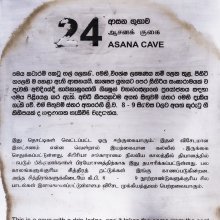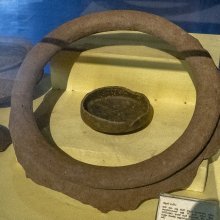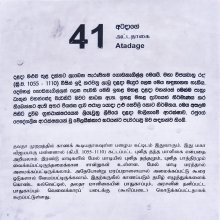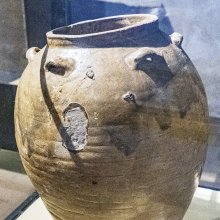Meya: 14 definitions
Introduction:
Meya means something in Hinduism, Sanskrit, the history of ancient India, Hindi, biology. If you want to know the exact meaning, history, etymology or English translation of this term then check out the descriptions on this page. Add your comment or reference to a book if you want to contribute to this summary article.
Images (photo gallery)
(+14 more images available)
In Hinduism
Shaktism (Shakta philosophy)
Source: Google Books: ManthanabhairavatantramMeya (मेय) refers to “object” (i.e., ‘that which is to be known’—Śiva) according to Abhinavagupta’s Mālinīvijayavārtika:—[...] Abhinavagupta proceeds to an exposition of the sixteen phases of the cycle of cognitive consciousness in relation to the sphere of the object (meya), symbolized by the Moon. This begins with a list of these phases. Note that the ‘object’, which in Sanskrit is called meya, which literally means ‘that which is to be known’, is ultimately Śiva, the pure conscious nature. Abhinava teaches that it is ‘I’ consciousness and is 'that which is to be known'. Accordingly, the sixteen phases leading to the perception of any object, if correctly and fully experienced, culminate in the liberated condition of the sixteenth phase, which is equated with the sixteenth energy of the Moon, as it is in the Kubjikā Tantras and those of other schools, although from a quite different perspective.

Shakta (शाक्त, śākta) or Shaktism (śāktism) represents a tradition of Hinduism where the Goddess (Devi) is revered and worshipped. Shakta literature includes a range of scriptures, including various Agamas and Tantras, although its roots may be traced back to the Vedas.
Shaiva philosophy
Source: archive.org: Chittanubodha Shastram By Bhaskara KanthaMeya (मेय) refers to an “object of knowledge”, according to the Cittānubodhaśāstra by Rājanaka Bhāskarakaṇṭha: an 18th century text dealing with aspects of Kashmir Śaivism such as the Pratyabhijñā (lit. “divine recognition”) philosophical branch.—The purport of the Cittānubodhaśāstra is to awaken the mind and to make it realize the truth of its own nature. [...] The twelfth chapter differentiates between kṛtya (object of action) and meya (object of knowledge) and their place in relation to the subjects from Śiva down to the individual.
-
India history and geography
Source: Cologne Digital Sanskrit Dictionaries: Indian Epigraphical GlossaryMeya.—(IE 8-5; EI 31; HRS), the share of grains to be paid to the king or landlord; revenue from agricultural land paid in kind; same as bhāga. Cf. tulya-meya, tax on commodities brought to market for sale. Note: meya is defined in the “Indian epigraphical glossary” as it can be found on ancient inscriptions commonly written in Sanskrit, Prakrit or Dravidian languages.

The history of India traces the identification of countries, villages, towns and other regions of India, as well as mythology, zoology, royal dynasties, rulers, tribes, local festivities and traditions and regional languages. Ancient India enjoyed religious freedom and encourages the path of Dharma, a concept common to Buddhism, Hinduism, and Jainism.
Biology (plants and animals)
Source: Google Books: CRC World Dictionary (Regional names)Meya in Common names is the name of a plant defined with Linariantha bicolor in various botanical sources. This page contains potential references in Ayurveda, modern medicine, and other folk traditions or local practices.
Example references for further research on medicinal uses or toxicity (see latin names for full list):
· Notes from the Royal Botanic Garden, Edinburgh (1965)
If you are looking for specific details regarding Meya, for example extract dosage, diet and recipes, side effects, health benefits, chemical composition, pregnancy safety, have a look at these references.

This sections includes definitions from the five kingdoms of living things: Animals, Plants, Fungi, Protists and Monera. It will include both the official binomial nomenclature (scientific names usually in Latin) as well as regional spellings and variants.
Languages of India and abroad
Sanskrit dictionary
Source: DDSA: The practical Sanskrit-English dictionaryMeya (मेय).—a. [mā-mi-vā yat]
1) Measured.
2) Capable of being estimated; तथा धरिममेयानां शतादभ्यधिके वधः (tathā dharimameyānāṃ śatādabhyadhike vadhaḥ) Ms. 8.321.
3) Discernible, capable of being known (jñeya).
Source: Cologne Digital Sanskrit Dictionaries: Shabda-Sagara Sanskrit-English DictionaryMeya (मेय).—mfn.
(-yaḥ-yā-yaṃ) Measurable, what is to be measured. E. mā to measure, yat aff.
Source: Cologne Digital Sanskrit Dictionaries: Cappeller Sanskrit-English DictionaryMeya (मेय).—[adjective] to be (being) measured; discernible, provable, demonstrable.
Source: Cologne Digital Sanskrit Dictionaries: Monier-Williams Sanskrit-English DictionaryMeya (मेय):—mfn. (√3. mā) to be measured, measurable, discernible, [Atharva-veda; Manu-smṛti; Mahābhārata etc.]
Source: Cologne Digital Sanskrit Dictionaries: Yates Sanskrit-English DictionaryMeya (मेय):—[(yaḥ-yā-yaṃ) a.] Measurable.
Source: DDSA: Paia-sadda-mahannavo; a comprehensive Prakrit Hindi dictionary (S)Meya (मेय) in the Sanskrit language is related to the Prakrit words: Mea, Mejja.
[Sanskrit to German]
Sanskrit, also spelled संस्कृतम् (saṃskṛtam), is an ancient language of India commonly seen as the grandmother of the Indo-European language family (even English!). Closely allied with Prakrit and Pali, Sanskrit is more exhaustive in both grammar and terms and has the most extensive collection of literature in the world, greatly surpassing its sister-languages Greek and Latin.
Hindi dictionary
Source: DDSA: A practical Hindi-English dictionaryMeya (मेय):—(a) measurable; ~[tā] measurability.
...
Kannada-English dictionary
Source: Alar: Kannada-English corpusMēya (ಮೇಯ):—
1) [adjective] that can be measured; measurable.
2) [adjective] that can be understood; clear; comprehensible; intelligible.
--- OR ---
Mēya (ಮೇಯ):—
1) [noun] that which can be measured; a thing that is measurable.
2) [noun] that which can be understood.
Kannada is a Dravidian language (as opposed to the Indo-European language family) mainly spoken in the southwestern region of India.
See also (Relevant definitions)
Starts with: Mey-avarku-kattalvina, Meyal, Meyam, Meyamaya, Meyan, Meyandzi, Meyar, Meyara, Meyaru, Meyavan, Meyawani.
Query error!
Full-text (+73): Sarameya, Prameya, Anumeya, Upameya, Ameya, Parimeya, Anupameya, Naimeya, Nimeya, Unmeya, Mushtimeya, Dharimameya, Pratimeya, Vaimeya, Meyam, Rokpo meya, Rokp meya, Uvameyam, Tulya-meya, Deya-meya.
Relevant text
Search found 32 books and stories containing Meya, Mēya; (plurals include: Meyas, Mēyas). You can also click to the full overview containing English textual excerpts. Below are direct links for the most relevant articles:
Cidgaganacandrika (study) (by S. Mahalakshmi)
Verse 33 [Forms of Manifestation] < [Chapter 2 - Second Vimarśa]
Verse 37 [Bindu and Visarga] < [Chapter 2 - Second Vimarśa]
Verse 184 [Eligibility for attainment of release from Saṃsāra] < [Chapter 4 - Fourth Vimarśa]
Prasthanatrayi Swaminarayan Bhashyam (Study) (by Sadhu Gyanananddas)
3. Mānādhīnā Meyasiddhi < [Chapter 2 - Analysis on the Basis Of Epistemology]
5.4. Classification of Ultimate Pramā < [Chapter 2 - Analysis on the Basis Of Epistemology]
Vyavaharamala: a text on Indian jurisprudence (by P. V. Rajee)
6. Weights and measures < [Chapter 2 - The place of Vyavaharamala in Sanskrit juridical texts]
Tiruvaymoli (Thiruvaimozhi): English translation (by S. Satyamurthi Ayyangar)
Pasuram 5.7.11 < [Section 7 - Seventh Tiruvaymoli (Norra Nonpu)]
Pasuram 7.3.11 < [Section 3 - Third Tiruvaymoli (Vellaic curi cankotu)]
Vastu-shastra (Introduction to Indian architecture) (by D. N. Shukla)
(iii) Proportionate measurements (Māna, Aṅgula, Hasta) < [Chapter 6 - Fundamental Canons of Hindu Architecture]
Chapter 1 - Denotation of the term ‘prāsāda’—the hindu temple < [Volume 5 - Temple Architecture]
(v) The character of the building aspect etc. (Patākādi-ṣaṭ-chandas) < [Chapter 6 - Fundamental Canons of Hindu Architecture]
Notices of Sanskrit Manuscripts (by Rajendralala Mitra)





